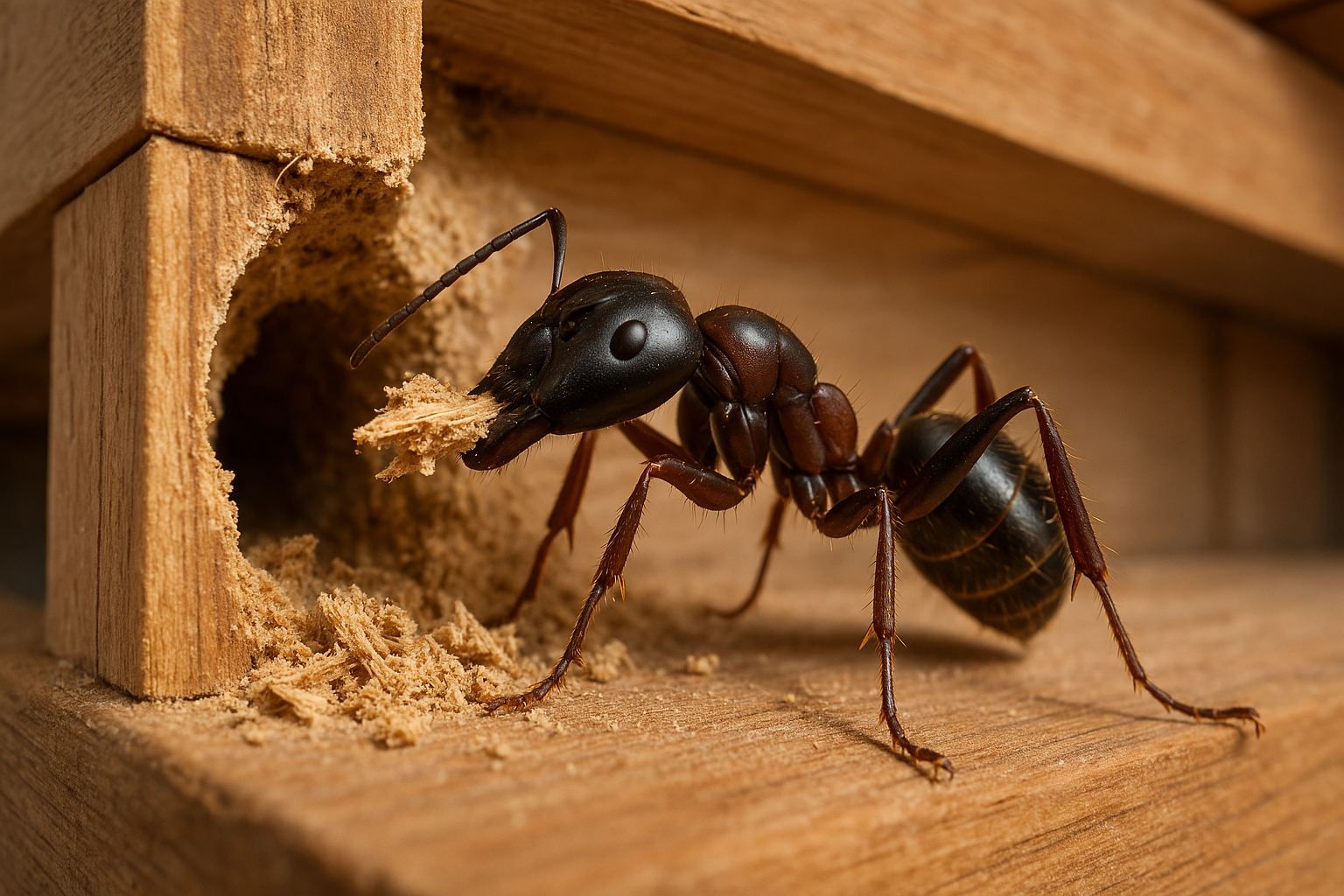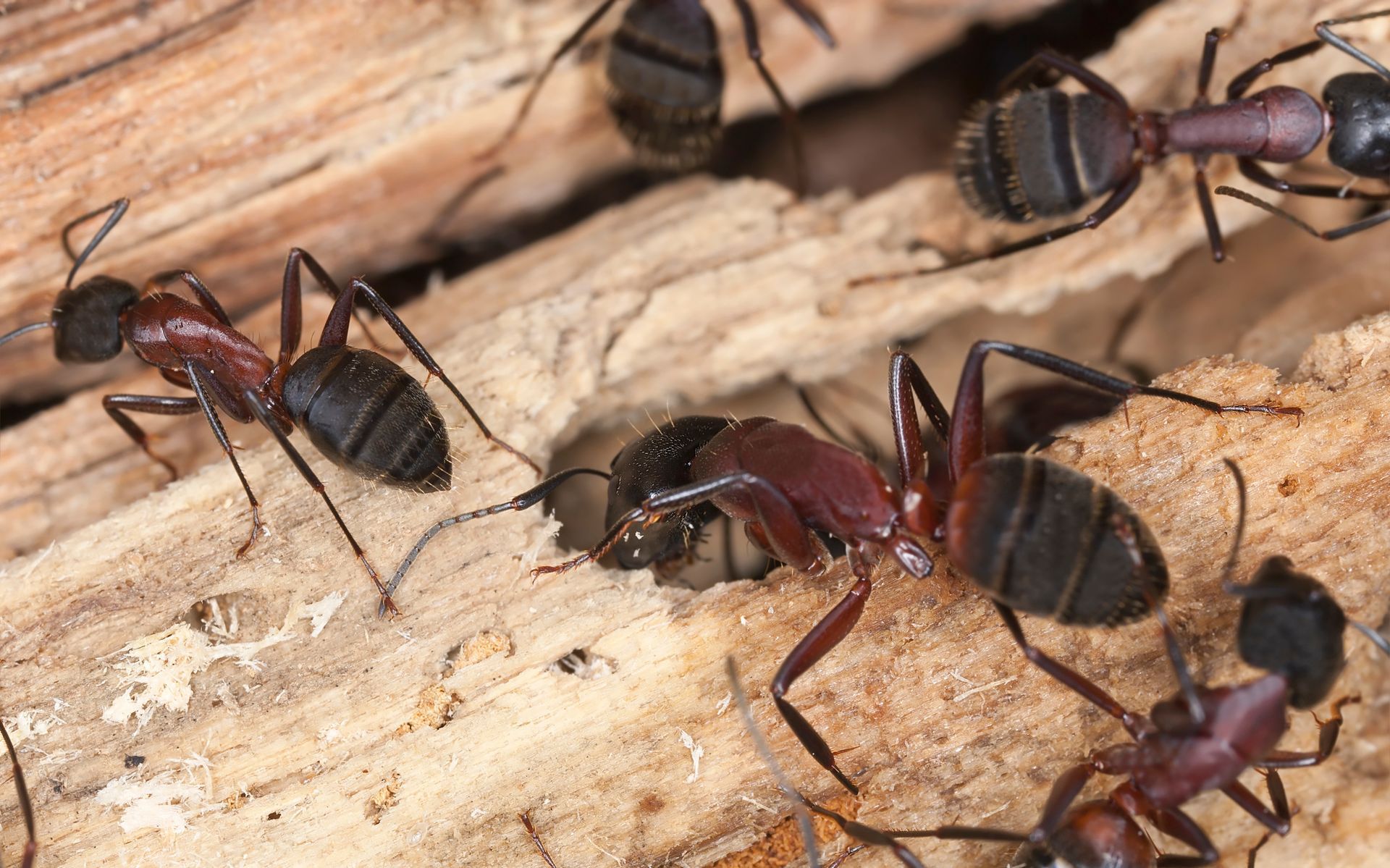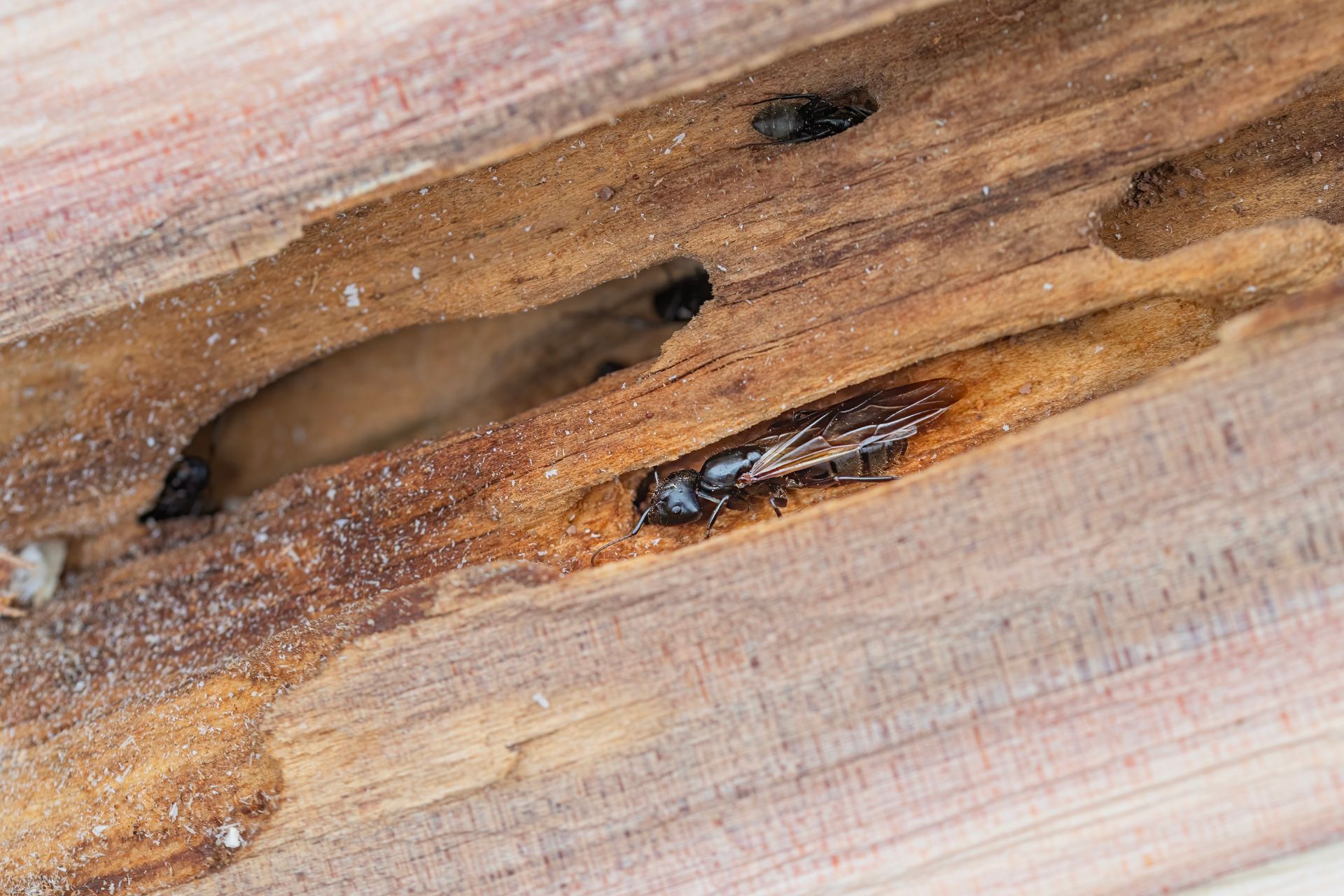Professional Carpenter Ant Removal Services
Finding sawdust like wood shavings beneath baseboards, hearing rustling sounds in walls, or spotting large black ants with workers of varying sizes signals a carpenter ant infestation requiring immediate professional intervention. These wood destroying insects excavate extensive gallery systems within structures, causing damage that compounds over time. At EcoGuard Pest Management, we deliver targeted carpenter ant control solutions that eliminate both parent and satellite colonies while preventing future infestations through our science based approach.
Call today for a free estimate. 866-328-2847
Pest FREE Guarantee
All Natural Services
Licensed & Insured
Competitive Pricing
Carpenter Ant Exterminators and Control Experts
Successful carpenter ant pest control demands extensive knowledge of colony structure, nesting preferences, and moisture dynamics. Our certified technicians receive specialized training in carpenter ant biology, damage assessment, and colony location techniques. This expertise allows us to distinguish carpenter ant activity from other wood destroying insects while implementing targeted control strategies that address both visible ants and hidden nests within structures.
Why Carpenter Ant Are a Serious Problem
Carpenter ants create unique challenges that require immediate professional attention:
- These insects excavate intricate gallery systems within wood. They prefer moisture damaged areas but are capable of expanding into sound lumber. Their tunneling creates extensive structural damage that often remains hidden behind walls until significant weakening occurs.
- Carpenter ant colonies establish satellite nests throughout structures, with worker ants traveling up to 100 yards from the parent colony. Each satellite nest contains hundreds of workers that continue expanding gallery systems, leading to widespread damage across multiple areas.
- Unlike termites that consume wood, carpenter ants create smooth, clean cut galleries while removing wood shavings, making early detection challenging. Their preference for moist, decaying wood often indicates underlying moisture issues that require correction to prevent future infestations.
- Mature colonies produce winged reproductives that emerge during spring swarms, establishing new colonies in other areas of structures. A single parent colony can support multiple satellite nests, each capable of further expansion and wood excavation.
Carpenter Ant Treatments Options
EcoGuard is a leader in carpenter ant control methodology and service.
Our comprehensive approach to carpenter ant treatment combines multiple strategies based on colony location and structure conditions:
- Colony Detection: Advanced inspection techniques using moisture meters and sound detection to locate both parent and satellite nests within structures.
- Targeted Treatments: Professional grade pesticide spray and foam applications precisely delivered to identified nest sites and travel routes.
- Barrier Protection: Creation of chemical barriers around structures while treating potential entry points to prevent new colony establishment.
- Bait Strategies: Strategic placement of professional ant baits that workers carry back to hidden nests, eliminating colonies at their source.
- Moisture Management: Identification and correction of moisture issues that attract carpenter ants and create favorable nesting conditions.
- Preventive Services: Implementation of ongoing monitoring and prevention strategies to protect structures from future carpenter ant activity.
What Causes Carpenter Ant Problems?
Understanding the factors that attract carpenter ants to your property is essential for effective control:
- Moisture Conditions: Leaking roofs, plumbing issues, poor ventilation, and improper drainage create the damp wood conditions carpenter ants prefer for nesting. These moisture problems soften wood, making it easier for ants to excavate their galleries.
- Vegetation Contact: Trees and shrubs touching buildings provide direct highways for carpenter ants to access structures. Dead tree stumps, rotting logs, and landscape timbers near buildings often harbor parent colonies that later spread into homes.
- Structural Vulnerabilities: Gaps around utility lines, foundation cracks, and roof intersections give carpenter ants direct access to wall voids and wooden structural elements.
- Food Resources: While carpenter ants don't eat wood, they actively forage for proteins and sweets. Improper food storage, outdoor insect populations, and honeydew producing insects in trees attract foraging workers who then discover suitable nesting sites.
Signs of a Carpenter Ant Infestation
Watch for these distinctive indicators of carpenter ant activity:
- Frass accumulations resembling coarse sawdust, often containing insect parts, beneath wood surfaces
- Worker ants varying in size from 1/4 to 1/2 inch, traveling in distinct trails, especially active at night
- Hollow sounding wood indicating internal gallery systems, particularly around windows and sills
- Faint rustling sounds in walls or wood structures, most noticeable during quiet nighttime hours
- Emergence of winged reproductive ants indoors during spring which signals a mature colony nearby
- Clean cut galleries in wood when damaged areas are exposed, showing smooth tunnels free of debris
DIY vs Professional Carpenter Ant Treatment
While hardware stores offer various carpenter ant control products, DIY approaches typically fail to resolve infestations. Over the counter sprays may kill visible ants but rarely reach nests hidden within walls, leading to continued colony growth and structural damage. Amateur treatments often result in colony fragmentation, causing ants to establish new satellite nests in untreated areas while leaving parent colonies intact to continue reproduction.
Professional carpenter ant control combines expert knowledge of ant biology, professional grade products, and comprehensive treatment strategies that eliminate entire colonies. Our technicians understand carpenter ant nesting preferences, foraging patterns, and colony structure, allowing them to find the nest and treat both parent and satellite colonies effectively while addressing conditions that attracted the ants initially.
Commercial Carpenter Ant Control
EcoGuard Pest Management delivers specialized carpenter ant control programs for businesses facing structural damage risks and regulatory compliance requirements. Our commercial services address the unique challenges carpenter ants present across different industries, protecting building integrity while maintaining operational efficiency.
We provide expert carpenter ant control solutions for:
- Office Complexes
- Healthcare Facilities
- Educational Institutions
- Hotels and Resorts
- Manufacturing Plants
- Retail Properties
- Restaurants
- Warehouses
- Historical Buildings
- Multi-Unit Housing
For immediate service for all of your carpenter ant control concerns please call 866-326-2847 or complete this form.
EcoGuard Carpenter Ant Guarantee
We understand the serious threat carpenter ants pose to your property and back our control services with a comprehensive guarantee. If carpenter ants return to treated areas during your covered service period, our technicians will promptly return to reassess and retreat at no additional cost. Our commitment extends beyond initial control to ensure lasting protection through regular monitoring of treated areas, assessment of moisture conditions, and rapid response to any new activity. Every service visit includes detailed documentation of findings and treatments to track progress and maintain effective control.
Pest Control Process
Initial Assessment: Our technicians conduct thorough property inspections focusing on moisture conditions, wood damage patterns, and ant activity trails. We pay particular attention to areas around plumbing, roof intersections, and wall voids.
Treatment Implementation: Based on inspection findings, we execute targeted treatments using a combination of professional grade products including residual sprays, insecticide dust applications, and specialized ant baits.
Exclusion and Prevention: Our comprehensive prevention approach focuses on sealing potential ant entry points while correcting moisture issues that attract carpenter ants. We also address underlying conditions through to ensure your property becomes less attractive to future carpenter ant colonies.
Ongoing Monitoring: Regular inspections of treated areas allow us to verify treatment effectiveness and identify any new carpenter ant activity before it develops into a serious problem.
Seasonal Plan for Carpenter Ant Control
Spring: Peak carpenter ant activity begins as temperatures warm, and colonies produce winged reproductives for mating flights. We focus on identifying parent colonies before swarmers emerge, implementing treatments to prevent new colony establishment while eliminating existing nests.
Summer: Maximum foraging activity occurs during warm months as colonies expand and establish satellite nests. Our technicians concentrate on tracking ant trails during evening hours, treating newly discovered nests, and maintaining barrier treatments around structures.
Fall: As temperatures cool, carpenter ants begin concentrating activity closer to their primary nests. We focus on treating these consolidation areas while implementing exclusion measures to prevent ants from establishing winter nests within heated structures.
Winter: While outdoor activity decreases, colonies within heated structures remain active year round. We conduct thorough inspections of interior spaces, particularly around heat sources and areas with potential moisture issues, treating indoor nests before spring expansion begins.
Carpenter Ant Control FAQs
How do carpenter ants differ from termites in their wood damage patterns?
Carpenter ants excavate smooth, clean galleries in wood, pushing sawdust like frass out through kickout holes, while termites actually consume wood and leave mud packed tunnels. Carpenter ant damage shows precisely cut galleries with a polished appearance, often following the wood grain, whereas termite damage contains rough tunnels filled with soil and fecal matter.
What role do satellite colonies play in carpenter ant infestations?
Satellite colonies extend from the parent nest, containing workers and mature larvae but no queen or eggs, allowing carpenter ants to expand their territory and damage multiple areas of a structure. These secondary nests can be located up to 100 yards from the parent colony, making thorough inspection crucial for complete control.
How do moisture levels affect carpenter ant colony development?
Carpenter ants specifically seek out wood with moisture content above 15%, often establishing initial colonies in areas affected by leaks, condensation, or poor ventilation. High moisture levels soften wood fibers, making excavation easier for the ants while providing the humid conditions they need for colony growth.
What sounds do carpenter ants make inside walls?
Carpenter ants produce a distinct rustling or crinkling sound as they excavate galleries and move through wall voids. These sounds are particularly noticeable during quiet nighttime hours. This noise, often described as similar to lightly crinkling cellophane, results from workers removing wood particles and maintaining their galleries.
How do carpenter ants communicate between colonies?
Carpenter ants use pheromone trails to mark foraging routes and communicate between parent and satellite nests which helps create established highways that other workers follow. These chemical signals help coordinate colony activities and food collection while enabling new workers to locate satellite nests and resources.
Why do winged carpenter ants appear inside homes?
The presence of winged carpenter ants indoors indicates a mature colony within the structure, typically appearing during spring as colonies prepare for reproduction and expansion. These swarmers emerge from established nests seeking mates and new nesting sites, often attracted to light sources and appearing suddenly in large numbers.
What time of year are carpenter ants most active?
Carpenter ants show peak activity during spring and summer months, with increased foraging and nest expansion occurring during warm weather periods. While outdoor activity decreases during winter, colonies within heated structures remain active year round and continue to cause damage despite seasonal changes.
How deep into wood structures do carpenter ants tunnel?
Carpenter ants can excavate galleries several inches deep into wooden structures, typically following the softer spring wood grain while leaving harder summer wood intact. Their galleries can extend throughout entire wooden members, with mature colonies creating extensive networks that compromise structural integrity over time.
What attracts carpenter ant scouts to specific properties?
Carpenter ant scouts are primarily attracted to moisture damaged wood, areas with high humidity, and easy access to food sources. They also seek out properties with abundant vegetation touching structures, which provides both food resources and direct access routes to potential nesting locations.
How do carpenter ant queens select new nesting sites?
Queen carpenter ants choose where to nest and lay eggs based on wood moisture content, shelter from elements, and proximity to food sources. They prefer softer, moisture damaged wood for establishing their first galleries, often selecting areas near ground level or in roof eaves where moisture accumulates.
Why do carpenter ants follow specific trails in homes?
Carpenter ants establish and maintain chemical trails between nest sites and food sources, following structural guidelines like wires, pipes, and edges. These trails become primary transportation routes for the colony, often remaining active for extended periods as long as resources remain available.
How do carpenter ants survive winter months?
Carpenter ants enter a semi dormant state during winter months when located in unheated outdoor areas, clustering together in their galleries to maintain warmth. However, colonies established within heated structures continue normal activity levels throughout winter which results in year round damage.
What role do worker ants play in colony expansion?
Worker carpenter ants are responsible for excavating new galleries, maintaining existing tunnels, and caring for developing larvae while also foraging for food to support colony growth. Their varying sizes allow different tasks to be performed efficiently, with larger workers capable of more extensive gallery excavation.
How quickly can carpenter ants damage structures?
While individual carpenter ant damage occurs gradually, mature colonies with multiple satellite nests can cause significant structural damage within 2-3 years of establishment. The rate of damage increases exponentially as colonies expand and establish additional satellite nests throughout the structure.
What signs indicate a mature carpenter ant colony?
Mature carpenter ant colonies typically produce winged reproductives and may contain thousands of workers varying in size from 1/4 to 1/2 inch long. Additional signs include substantial frass accumulation, distinct foraging trails, and the presence of multiple satellite nests throughout the structure.
How do professionals track carpenter ant colony locations?
Professional technicians use a combination of moisture meters, sound detection devices, and detailed visual inspection techniques to locate carpenter ant nests within structures. They also conduct nighttime inspections to track foraging patterns and identify primary travel routes between nest sites.
What factors determine treatment duration for carpenter ants?
Treatment duration depends on colony size, number of satellite nests, extent of structural damage, and underlying moisture conditions requiring correction. Complete control typically requires several weeks to ensure elimination of both parent and satellite colonies while addressing conditions that attracted the ants initially.
How do carpenter ants establish satellite nests?
Carpenter ants establish satellite nests by moving larvae and pupae from the parent colony to new locations, typically choosing areas with suitable moisture conditions and easy access to food sources. These secondary nests expand the colony's foraging territory while providing additional space for colony growth.
Why do carpenter ants prefer certain types of wood?
Carpenter ants show strong preference for softened, moisture damaged wood because it's easier to excavate and provides the humidity levels they need for colony development. They particularly target wood affected by fungal decay or water damage, though they can expand into sound wood once established.
How do temperature changes affect carpenter ant activity?
Carpenter ant activity increases significantly when temperatures rise above 60°F, with peak foraging occurring during warm nights. Temperature fluctuations influence both foraging patterns and colony expansion rates, while sustained warm periods often trigger reproductive swarming events.
How do you get rid of carpenter ants permanently?
Permanent carpenter ant elimination requires a comprehensive approach combining moisture control, wood repair, professional treatments targeting both parent and satellite colonies, and ongoing monitoring. Success depends on proper identification of all nest locations, correction of conducive conditions, and implementation of preventive measures to protect against future infestations.
Who to call to get rid of carpenter ants?
Professional pest control companies with specific experience in carpenter ant control and wood destroying insect management like EcoGuard provide the most effective solutions for carpenter ant infestations. Our licensed pest control technicians have access to commercial grade products and specialized training in carpenter ant biology and control methods that ensure complete colony elimination.
What will an exterminator do for carpenter ants?
A professional exterminator will conduct a thorough inspection to locate parent and satellite colonies, identify moisture issues, and develop a targeted treatment plan using a combination of methods including sprays, baits, and dust applications. They will also assess structural conditions contributing to the carpenter ant infestation, provide moisture control recommendations, and implement a comprehensive treatment strategy that addresses both immediate control and long-term prevention.
Additional Carpenter Ant Resources
Additional Pest Commonly Treated
See our Pest Library for a full list of insects we treat for. If you don’t see what you are looking for give us a call. We are always here to help! EcoGuard Pest Management provides eco-friendly services for both residential and commercial properties.
Why Choose EcoGuard?
- A pest free guarantee
- Green & ecofriendly pesticides that are state approved
- Licensed, bonded, and insured services
- Competitive pricing







